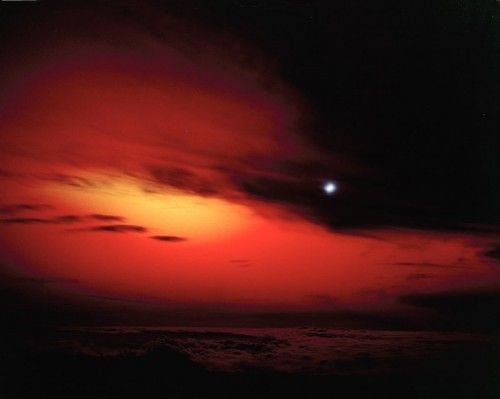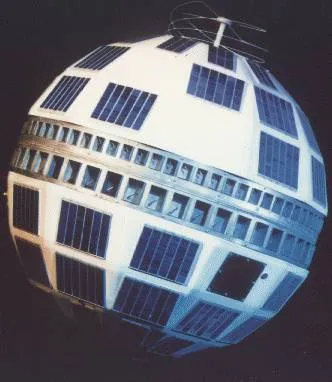Going Nuclear Over the Pacific
A half-century ago, a U.S. military test lit up the skies and upped the ante with the Soviets
/https://tf-cmsv2-smithsonianmag-media.s3.amazonaws.com/filer/20120815105052los-alamos-pacific-atomic-explosion-web.jpg)
The summer of 2012 will be remembered as a time when people around the world were caught up in events in the skies above Mars, where the rover Curiosity eventually touched down onto the red planet. Fifty years ago this summer there were strange doings in the skies above earth as well. In July 1962, eight airplanes, including five commercial flights, plummeted to the ground in separate crashes that killed hundreds. In a ninth incident that month, a vulture smashed through the cockpit window of an Indian Airlines cargo plane, killing the co-pilot. Higher in the atmosphere, cameras mounted in U-2 spy planes soaring above the Carribean captured images of Soviet ships that, unbeknownst to the U.S. at the time, were carrying missiles to Cuba.
In gray skies over Cape Cod, a 20-year-old telephone operator named Lois Ann Frotten decided to join her new fiancé in a celebratory jump from an airplane at 2,500 feet. It was her first attempt at skydiving. While her fiancé landed safely, Frotten’s chute got tangled and failed to open fully. She tumbled end over end and landed feet-first in Mystic Lake with a terrific splash—and survived the half-mile free fall with a cut nose and two small cracked vertebrae. “I’ll never jump again,” she told rescuers as she was pulled from the lake.
But of all the things happening in the skies that summer, nothing would be quite as spectacular, surreal and frightening as the military project code-named Starfish Prime. Just five days after Americans across the country witnessed traditional Fourth of July fireworks displays, the Atomic Energy Commission created the greatest man-made light show in history when it launched a thermonuclear warhead on the nose of a Thor rocket, creating a suborbital nuclear detonation 250 miles above the Pacific Ocean.

In the fifty minutes that followed, witnesses from Hawaii to New Zealand were treated to a carnival of color as the sky was illuminated in magnificent rainbow stripes and an artificial aurora borealis. With a yield of 1.45 megatons, the hydrogen bomb was approximately 100 times more powerful than the atomic bomb dropped on Hiroshima 17 years before. Yet scientists underestimated the effects of the bomb and the resulting radiation.
Knowledge of radiation in space was still fragmentary and new. It was only four years before that James A. Van Allen, a University of Iowa physicist who had been experimenting with Geiger counters on satellites, claimed to have discovered that the planet was encircled by a “deadly band of X-rays,” and that radiation from the sun “hit the satellites so rapidly and furiously” that the devices jammed. Van Allen announced his findings on May 1, 1958, at a joint meeting of the National Academy of Sciences and the American Physical Society, and the following day, the Chicago Tribune bannered the headline, “Radiation Belt Dims Hope of Space Travel.” The story continued: “Death, lurking in a belt of unexpectedly heavy radiation about 700 miles above the earth, today dimmed man’s dreamed of conquering outer space.”
News of the “hot band of peril” immediately cast doubt on whether Laika, the Russian dog, would have been able to survive for a week in space aboard Sputnik II, as the Soviets claimed, in November of 1957. (The Soviets said that after six days, the dog’s oxygen ran out and she was euthanized with poisoned food. It was later learned that Laika, the first live animal to be launched into space, died just hours after the launch from overheating and stress, when a malfunction in the capsule caused the temperature to rise.)
What Van Allen had discovered were the bands of high-energy particles that were held in place by strong magnetic fields, and soon known as the Van Allen Belts. A year later, he appeared on the cover of Time magazine as he opened an entirely new field of research—magnetospheric physics—and catapulted the United States into the race to space with the Soviet Union.
On the same day Van Allen held his press conference in May 1958, he agreed to cooperate with the U.S. military on a top-secret project. The plan: to send atomic bombs into space in an attempt to blow up the Van Allen Belts, or to at least disrupt them with a massive blast of nuclear energy.
At the height of the Cold War, the thinking may have been, as the science historian James Fleming said recently, that “if we don’t do it, the Russians will.” In fact, over the next few years, both the United States and the Soviet Union tested atomic bombs in space, with little or no disruption in the Van Allen Belts. Fleming suspects that the U.S. military may have theorized that the Van Allen belts could be used to attack the enemy. But in July 1962, the United States was ready to test a far more powerful nuclear bomb in space
The first Starfish Prime launch, on June 20, 1962, at Johnston Island in the Pacific, had to be aborted when the Thor launch vehicle failed and the missile began to break apart. The nuclear warhead was destroyed mid-flight, and radioactive contamination rained back down on the island.

Despite protests from Tokyo to London to Moscow citing “the world’s violent opposition” to the July 9 test, the Honolulu Advertiser carried no ominous portent with its headline, “N-Blast Tonight May Be Dazzling; Good View Likely,” and hotels in Hawaii held rooftop parties.
The mood on the other side of the planet was somewhat darker. In London, England, 300 British citizens demonstrated outside the United States Embassy, chanting “No More Tests!” and scuffling with police. Canon L. John Collins of St. Paul’s Cathedral called the test “an evil thing,” and said those responsible were “stupid fools.” Izvestia, the Soviet newspaper, carried the headline, “Crime of American Atom-mongers: United States Carries Out Nuclear Explosion in Space.”
Soviet film director Sergei Yutkevich told the paper, “We know with whom we are dealing: yet we hoped, until the last moment, that the conscience, if not the wisdom, of the American atom-mongers would hear the angry voices of millions and millions of ordinary people of the earth, the voices of mothers and scientists of their own country.” (Just eight months before, the Soviets tested the Tsar Bomba, the most powerful nuclear weapon ever detonated—a 50-megaton hydrogen bomb—on an archipelago in the Arctic Ocean in the north of Russia.)
Just after 11 p.m. Honolulu time on July 9, the 1.45-megaton hydrogen bomb was detonated thirteen minutes after launch. Almost immediately, an electromagnetic pulse knocked out electrical service in Hawaii, nearly 1,000 miles away. Telephone service was disrupted, streetlights were down and burglar alarms were set off by a pulse that was much larger than scientists expected.
Suddenly, the sky above the Pacific was illuminated by bright auroral phenomena. “For three minutes after the blast,” one reporter in Honolulu wrote, “the moon was centered in a sky partly blood-red and partly pink. Clouds appeared as dark silhouettes against the lighted sky.” Another witness said, “A brilliant white flash burned through the clouds rapidly changing to an expanding green ball of irradiance extending into the clear sky above the overcast.” Others as far away as the Fiji Islands—2,000 miles from Johnston Island—described the light show as “breathtaking.”
In Maui, a woman observed auroral lights that lasted a half hour in “a steady display, not pulsating or flickering, taking the shape of a gigantic V and shading from yellow at the start to dull red, then to icy blue and finally to white.”
“To our great surprise and dismay, it developed that Starfish added significantly to the electrons in the Van Allen belts,” Atomic Energy Commission Glenn Seaborg wrote in his memoirs. “This result contravened all our predictions.”
More than half a dozen satellites had been victimized by radiation from the blast. Telstar, the AT&T communications satellite launched one day after Starfish, relayed telephone calls, faxes and television signals until its transistors were damaged by Starfish radiation. (The Soviets tested their own high-altitude thermonuclear device in October 1962, which further damaged Telstar’s transistors and rendered it useless.)
Both the Soviets and the United States conducted their last high-altitude nuclear explosions on November 1, 1962. It was also the same day the Soviets began dismantling their missiles in Cuba. Realizing that the two nations had come close to a nuclear war, and prompted by the results of Starfish Prime and continuing atomic tests by the Soviets, President John F. Kennedy and Premier Nikita Khrushchev signed the Limited Nuclear Test Ban Treaty on July 25, 1963, banning atmospheric and exoatmospheric nuclear testing. And while the U.S. and the Soviet Union would continue their race to space at full throttle, for the time being, the treaty significantly slowed the arms race between the two superpowers.
Sources
Books: James Clay Moltz, The Politics of Space Security: Strategic Restraint and the Pursuit of National Interests, Stanford University Press, 2008. Rosemary B. Mariner and G. Kurt Piehler, The Atomic Bomb and American Society: New Perspectives, The University of Tennessee Press, 2009.
Articles: “H-Blast Seen 4000 Miles, Triggers Russian Outcry,” Boston Globe, July 10, 1962. “Britons Protest Outside Embassy,” New York Times, July 10, 1962. “Pacific Sky Glows After Space Blast,” Hartford Courant, July 10, 1962. “Blackouts Last Only About Hour,” New York Times, July 10, 1962. “How Not to Test in Space” by Michael Krepon, The Stimson Center, November 7, 2011, http://www.stimson.org/summaries/how-not-to-test-in-space-/ “A Very Scary Light Show: Exploding H-Bombs in Space” Krulwich Wonders, NPR, All Things Considered, July 1, 2010, http://www.npr.org/templates/story/story.php?storyId=128170775 “9 July 1962 ‘Starfish Prime’, Outer Space” The Comprehensive Nuclear-Test-Ban-Treaty-Organization Preparatory Commission, http://www.ctbto.org/specials/infamous-anniversaries/9-july-1962starfish-prime-outer-space/ “Nuclear Test Ban Treaty” John F. Kennedy Presidential Library and Museum, http://www.jfklibrary.org/JFK/JFK-in-History/Nuclear-Test-Ban-Treaty.aspx
/https://tf-cmsv2-smithsonianmag-media.s3.amazonaws.com/accounts/headshot/gilbert-king-240.jpg)
/https://tf-cmsv2-smithsonianmag-media.s3.amazonaws.com/accounts/headshot/gilbert-king-240.jpg)